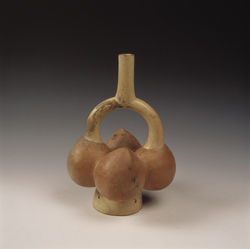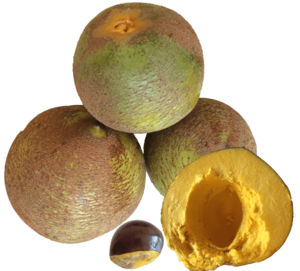Lúcuma facts for kids
Quick facts for kids Lúcuma |
|
|---|---|
 |
|
| Branchlet with leaves, flowers and fruit of Pouteria lucuma: Fruit cut in half shown on top left of image | |
| Scientific classification | |
| Synonyms | |
|
The lúcuma (scientific name: Pouteria lucuma) is a special fruit that grows on a tree. It belongs to the Sapotaceae family. People grow these trees for their delicious fruit, also called lúcuma. This fruit originally comes from the Andean valleys. You can find it in countries like Bolivia, Chile, Ecuador, and Peru.
Contents
What the Lúcuma Tree Looks Like
The lúcuma tree is an evergreen tree, meaning it keeps its leaves all year. It can grow up to 20 meters (about 65 feet) tall. Its bark is grey-brown and has cracks. If you cut the bark, a milky white liquid comes out.
The ends of the branches and the leaf stems have short, brown hairs. The leaves are simple and shaped like a spoon or oval. They can be up to 25 cm (10 inches) long and 10 cm (4 inches) wide. They are usually smooth, but sometimes have a few hairs on the underside. Leaves grow in groups at the end of the branches.
The flowers are small and grow alone or in small bunches. They are found where the leaves meet the stem. The flowers have hairy green parts called sepals. The main part of the flower, the corolla, forms a tube about 1 to 1.8 cm long. It is greenish-white and has five small parts called lobes.
The fruit is round and measures 6 to 12 cm (2.4 to 4.7 inches) long. It is smooth and turns a reddish-yellow color when it's ripe. Inside, the fruit has bright yellow flesh. Each fruit usually has one to several seeds. These seeds are dark brown, shiny, and about 1.8 to 3.5 cm (0.7 to 1.4 inches) long.
History of Lúcuma

Lúcuma has been important to people for a very long time. Ancient people in coastal Peru used to make art showing lúcuma. For example, the Moche culture was very interested in farming. They often made pottery and other art that showed fruits and vegetables, including lúcuma.
Europeans first learned about lúcuma in 1531. They saw the fruit in Ecuador.
Where Lúcuma Grows Naturally
The lúcuma tree first grew in the Andes mountains of Ecuador and Peru. It likes to grow in places that are not too hot or too cold. These areas are usually at high elevations, between 2,700 and 3,000 meters (about 8,850 to 9,840 feet) above sea level.
How Lúcuma is Grown
| Nutritional value per 100 g (3.5 oz) | |
|---|---|
| Energy | 414.5 kJ (99.1 kcal) |
|
1.5 %
|
|
| Dietary fiber | 1.3 % |
|
0.5 %
|
|
|
Protein
|
1.5 %
|
| Vitamins | Quantity
%DV†
|
| Thiamine (B1) |
1%
0.01 mg |
| Riboflavin (B2) |
12%
0.14 mg |
| Niacin (B3) |
12%
1.96 mg |
| Vitamin C |
3%
2.2 mg |
| Minerals | Quantity
%DV†
|
| Calcium |
2%
16 mg |
| Iron |
3%
0.4 mg |
| Phosphorus |
4%
26 mg |
| Potassium |
16%
470 mg |
| Sodium |
0%
6 mg |
| Other constituents | Quantity |
| Water | 64.8 - 72.3 % |
| †Percentages estimated using US recommendations for adults. | |
Besides Peru, lúcuma is also grown in other countries. You can find it in Bolivia, Chile, and Costa Rica. It is also grown in Vietnam, where it is called lêkima. It's hard to grow lúcuma in places like Florida because the climate is not right.
The harvesting season for lúcuma is different depending on the country. In Peru, people pick lúcuma from October to March. In Chile, the season is from June to November.
How People Use Lúcuma
When you eat lúcuma raw, it is very sweet. The fruit's flesh is bright yellow. It has a texture that can feel a bit dry or mealy.
In Peru, lúcuma is very popular as a flavor. People often use it in juices, milkshakes, and especially in ice cream. Its taste is unique and hard to describe. Some people say it tastes like sweet potato, while others think it's like maple syrup or butterscotch.
A popular Peruvian dessert is called manjar de lúcuma. This is a sweet spread, similar to dulce de leche, mixed with lúcuma purée. Many people say lúcuma is the most popular ice cream flavor in Peru. It is also one of the most loved fresh fruits there.
Nutrition Facts About Lúcuma
The yellow flesh of the lúcuma fruit is mostly water, about 64-72%. It also contains natural sugars like glucose, fructose, and sucrose. Other helpful substances found in lúcuma include inositol, citric acid, and succinic acid.
There isn't a lot of detailed nutrition information for lúcuma powder. However, it is known to have a moderate amount of protein and iron. A 100-gram (3.5 ounce) serving can provide about 14% of the recommended daily amount for both protein and iron. This serving also gives you about 420 Calories.
See also
 In Spanish: Lúcuma para niños
In Spanish: Lúcuma para niños


